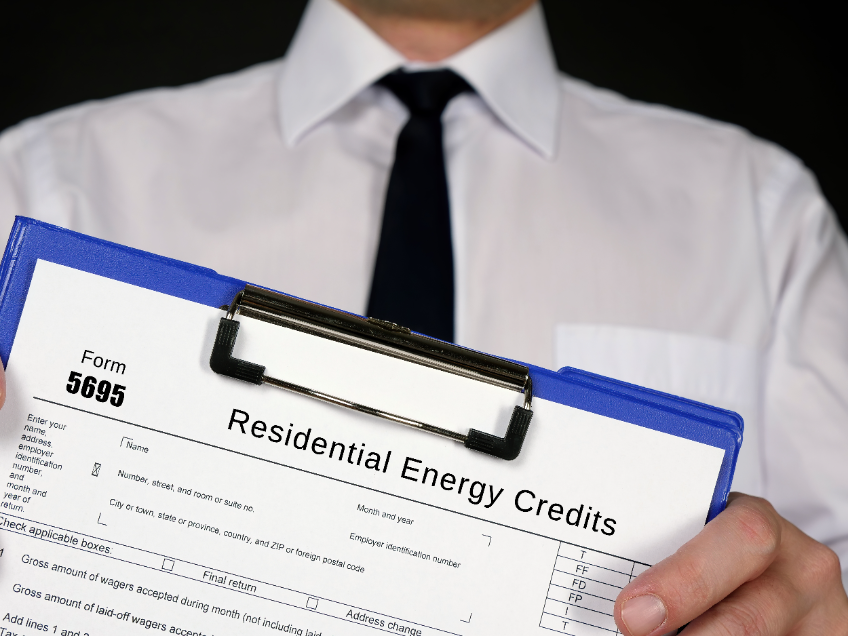
Filling out Form 5695 of the Internal Revenue Service (IRS) to claim the Solar Tax Credit is an easy process, but there are a few important details that you need to know in order to make sure your claim is valid. First, you’ll need to gather all the necessary information about any energy-efficient improvements you’ve made to your home, such as solar water heating, geothermal heat pumps, or solar panels. You’ll also need to calculate the costs associated with these improvements. Once you have all the required data, simply input it into lines 1 through 10 of Form 5695.
Form 5695 also allows for credits for other types of energy-saving improvements such as qualified energy efficiency improvements and items of energy conservation. You can find more detailed information about these credits on lines 11 through 17 of Form 5695. Additionally, there’s an unused portion credit for fuel cells, small wind turbines and geothermal heat pump property which can be found on lines 18 and 19. For more information about how to fill out IRS Form 5695 to claim the Solar Tax Credit, consult Publication 535 from the IRS website or speak with a tax professional.
Qualified Energy Property Costs
Qualified energy property costs are expenses related to the installation of certain energy-saving improvements and items for your home or business. Examples of these include solar water heating, geothermal heat pumps, solar panels, fuel cells, small wind turbines and other energy conservation products. When you make these improvements to your home or business, you can claim a nonbusiness energy property credit on IRS Form 5695. This credit is based on the amount of money you spend on qualified energy property costs. In order to be eligible for the credit, the cost must be for new materials and installation services that meet certain energy efficiency requirements specified by the IRS. Additionally, any improvements must be made within three years of when you file Form 5695 in order to qualify for the credit. If done correctly, taking advantage of this tax credit could save you money while helping reduce your environmental impact.
Eligible Items of Energy Property
The non-business energy property credit allows individuals to claim a credit for certain qualified energy-efficient improvements and items, including solar water heating systems, geothermal heat pumps, solar panels, fuel cells, small wind turbines and other energy conservation products. This tax credit can be claimed on IRS Form 5695 and is based on the cost of eligible items of energy property that meet certain requirements set forth by the IRS. Qualifying expenses include both the purchase price of the materials as well as installation services. Furthermore, in order to qualify for the credit, any improvements must have been made within three years of when you file Form 5695. The non-business energy property credit provides an opportunity for homeowners and businesses alike to save money while also investing in renewable energies like solar and wind power. Taking advantage of this tax incentive can help reduce your environmental impact while putting some extra cash back into your pocket.
Qualified Non-Business Energy Property Credit (IRC 25D)
The Qualified Non-Business Energy Property Credit (IRC 25D) is a great way for individuals to save money on their taxes while also investing in renewable energy. This tax credit allows taxpayers to claim a credit for certain qualified energy-efficient improvements and items, such as solar water heating systems, geothermal heat pumps, solar panels, fuel cells, small wind turbines and other energy conservation products. The credit can be claimed on IRS Form 5695 and is based on the cost of eligible energy property that meets certain requirements set forth by the IRS. These requirements include qualifying expenses such as both the purchase price of the materials and installation services, as well as making any improvements within three years of filing Form 5695. Taking advantage of this tax incentive can help reduce an individual’s environmental impact while putting some extra cash back into their pocket.
Qualified Fuel Cell Property Credit (IRC 30C)
Qualified Fuel Cell Property Credit (IRC 30C) is a great way for individuals to save money on their taxes while investing in clean energy. This tax credit allows taxpayers to claim a credit for the purchase of qualified fuel cells and related components, such as installation services and other energy conservation products. To be eligible for this tax credit, the fuel cell system must meet certain requirements set forth by the IRS. These requirements include having an electricity-only generation efficiency rating of at least 30%, a fuel cell capacity of at least 0.5 kilowatts, and being installed on or in connection with residential property located in the United States. If these requirements are met, then the taxpayer can claim a credit up to $500 for each one-half kilowatt of power capacity of the qualified fuel cell property on IRS Form 5695. Taking advantage of this tax incentive can help reduce an individual’s environmental impact while putting some extra cash back into their pocket.
Qualified Small Wind Energy Property Credit (IRC 48(a))
Qualified Small Wind Energy Property Credit (IRC 48(a)) is a great way for individuals to save money on their taxes while investing in renewable energy. This tax credit allows taxpayers to claim a credit of up to 30% of the cost of qualified small wind energy property. To be eligible for this tax credit, the wind energy system must meet certain requirements set forth by the IRS. These requirements include having installed capacity of up to 100 kilowatts, being located in the United States, and having begun construction after 2008 or beginning construction before 2020 and placed into service before 2023. If these requirements are met, then the taxpayer can claim a credit on IRS Form 5695 for an amount equal to 30% of eligible costs paid or incurred during the taxable year for qualified small wind energy property. Taking advantage of this tax incentive can help reduce an individual’s environmental impact while putting some extra cash back into their pocket.
Geothermal Heat Pump Property Credit (IRC 25D)
Geothermal Heat Pump Property Credit (IRC 25D) is an excellent way for individuals to save money on their taxes while investing in energy efficiency. This nonrefundable tax credit allows taxpayers to claim a credit of up to 30% of the cost of qualified geothermal heat pump property that is installed on or in connection with their main home located in the United States. To be eligible for this tax credit, the geothermal heat pump property must meet certain requirements as set forth by the IRS. These requirements include having at least a half ton of cooling capacity and being used primarily for heating and cooling purposes. Additionally, it must be certified by the manufacturer as meeting applicable Energy Star program requirements. If these requirements are met, then the taxpayer can claim a credit on IRS Form 5695 for an amount equal to 30% of eligible costs paid or incurred during the taxable year for qualified geothermal heat pump property. Taking advantage of this tax incentive can help reduce an individual’s environmental impact while also providing them with some money back from their investment in energy-efficient improvements.
Combined Heat and Power System Credit (IRC 48(c))
Combined Heat and Power System Credit (IRC 48(c)) is an excellent way for businesses to save money on their taxes while investing in energy efficiency. This nonrefundable tax credit allows businesses to claim a credit of up to 10% of the cost of qualified combined heat and power system property that is installed on or in connection with their main place of business, provided that the system qualifies as “energy efficient” according to requirements set forth by the IRS. To qualify, the combined heat and power system must produce electricity and useful thermal energy from a single fuel source, have an electric generating capacity greater than 20 kilowatts but no more than 100 kilowatts per unit, meet certain efficiency requirements, and be certified as meeting applicable Energy Star program requirements. If these criteria are met, then the taxpayer can claim a credit on IRS Form 5695 for an amount equal to 10% of eligible costs paid or incurred during the taxable year for qualified combined heat and power system property. Businesses looking to reduce their environmental impact while also benefiting from significant tax savings should consider taking advantage of this beneficial tax incentive.
Solar Water Heating and Solar Electric Property Credits (IRC 25D)
The Solar Water Heating and Solar Electric Property Credits (IRC 25D) are an excellent way for taxpayers to save money on their taxes and invest in energy efficiency. This nonrefundable credit allows individuals to claim a credit of up to 30% of the cost of qualified solar water heating property, solar electric property, or fuel cell property that is installed in their home. To qualify, the system must be certified as meeting applicable Energy Star program requirements. For solar water heating property, it must heat water for use in a dwelling unit located in the United States and used as a residence by the taxpayer, be placed in service before December 31st 2021 (or December 31st 2022 for fuel cell property), meet certain energy efficiency requirements and be certified by the manufacturer as meeting applicable Energy Star program requirements. If these criteria are met, then taxpayers can claim a credit on IRS Form 5695 for an amount equal to 30% of eligible costs paid or incurred during the taxable year for qualified solar water heating or electric property. Homeowners looking to reduce their environmental impact while also benefiting from significant tax savings should consider taking advantage of this beneficial tax incentive.
The Residential Energy Efficient Tax Credits (IRC 25C) are an excellent way for homeowners to save money on their taxes and invest in energy efficiency. This nonrefundable credit allows individuals to claim a credit of up to 10% of the cost of qualified property, including certain energy-efficient improvements and residential energy property costs, that is installed in their home. Qualified improvements include windows, doors and insulation materials. Qualified residential energy property costs include geothermal heat pumps, solar panel systems, small wind energy systems and fuel cell property. To qualify, the system must be certified as meeting applicable Energy Star program requirements. Homeowners looking to reduce their environmental impact while also benefiting from significant tax savings should consider taking advantage of this beneficial tax incentive. The credit can be claimed on IRS Form 5695 and any unused portion may be carried forward for five additional years.
Nonbusiness Energy Property Credit Requirements (IRC 25C)
Nonbusiness energy property credits are a federal tax credit available to homeowners who make energy efficiency improvements in their homes. The credit, which is part of the Internal Revenue Code (IRC) 25C, allows homeowners to claim up to 10% of the cost of qualified energy property and certain residential energy costs. Qualified improvements include items such as solar water heating systems, geothermal heat pumps, fuel cells, windows and doors. To qualify for the credit, the system must meet applicable Energy Star program requirements. Homeowners should keep receipts of all qualifying purchases and fill out IRS Form 5695 to claim this beneficial tax incentive. It is important to note that any unused portion of the credit may be carried forward for five additional years. Improving home energy efficiency can not only save money on taxes but also have a positive impact on the environment by reducing greenhouse gas emissions.
Requirements for the Residential Energy Efficient Tax Credits
The residential energy efficient tax credits are an incentive to help homeowners save money while making improvements to their homes. These credits are available for items such as solar water heating systems, geothermal heat pumps, fuel cells, windows and doors that meet certain Energy Star program requirements. To qualify for the credit, homeowners must fill out IRS Form 5695 and provide receipts for all qualifying purchases. The amount of the credit is up to 10% of the cost of qualified energy property and certain residential energy costs. Any unused portion of the credit may be carried forward for five additional years. Homeowners can not only save money on taxes but also make a positive impact on the environment by reducing greenhouse gas emissions with energy saving improvements.

Sarah Nieschalk
Sarah E. Deierlein Nieschalk, EA, is an experienced tax professional with over a decade of expertise representing taxpayers before the IRS. As an Enrolled Agent and Assistant Vice President of Servicing at Community Tax, LLC, Sarah specializes in resolving complex federal and state tax collection issues, including high-dollar individual liabilities, employment tax challenges, and corporate audits. Since becoming an Enrolled Agent in 2012, she has resolved over 5,000 cases, saving millions for clients while protecting countless businesses. Outside of work, Sarah enjoys painting, staying active, and raising her family of rescued dogs while contributing to nonprofit causes through storytelling events.







